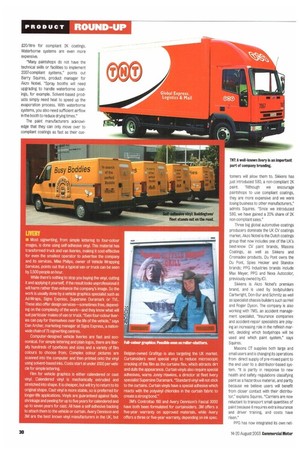LIVERY • Most signwriting, from simple lettering to four-colour images,
Page 30

If you've noticed an error in this article please click here to report it so we can fix it.
is done using self-adhesive vinyl. This material has transformed truck and van liveries, making it cost-effective for even the smallest operator to advertise the company and its services. Mike Philips, owner of Vehicle Wrapping Services, points out that a typical van or truck can be seen by 3,500 people an hour.
While there's nothing to stop you buying the vinyl, cutting it and applying it yourself, if the result looks unprofessional it will harm rather than enhance the company's image. So the work is usually done by a vehicle graphics specialist such as Ad-Wraps, Signs Express, Supersine Duramark or TVL. These also offer design services—sometimes free, depending on the complexity of the work—and they know what will suit particular makes of van or truck. "Even four-colour liveries can pay for themselves over the life of the vehicle," says Dan Archer, marketing manager at Signs Express, a nationwide chain of 75 sig,nwriting centres.
Computer-designed vehicle liveries are fast and economical. For simple lettering and plain logos, there are literally hundreds of typefaces and sizes and a variety of film colours to choose from. Complex colour pictures are scanned into the computer and then printed onto the vinyl using solvent-based inks. Costs start at under /100 per vehicle for simple lettering.
Film for vehicle graphics is either calendered or cast vinyl. Calendered vinyl is mechanically extruded and stretched into shape. It is cheaper, but will try to return to its original shape. Cast vinyl is more stable, so is preferred for longer-life applications. Vinyls are guaranteed against fade, shrinkage and peering for up to five years for calendered and up to seven years for cast. All have a self-adhesive backing to attach them to the vehicle or curtain. Avery Dennison and 3M are the best known vinyl manufacturers in the UK, but Belgian-owned Grafrtyp is also targeting the UK market. Curtainsiders need special vinyl to reduce microscopic cracking of the film as the curtains flex, which attracts dirt and dulls the appearance. Curtain vinyls also require special adhesives, warns Jonny Hawkins, a director at fleet livery specialist Super-sine Duramark. "Standard vinyl will not stick to the curtains. Curtain vinyls have a special adhesive which reacts with the polyvinyl chlorides in the curtain fabric to create a strong bond."
3M's Controltac 190 and Avery Dennison's Fascal 3000 have both been formulated for curtainsders. 3M offers a five-year warranty on approved materials, while Avery offers a three or five-year warranty, depending on ink spec.
































































































































































